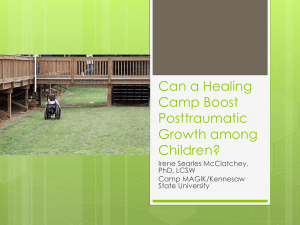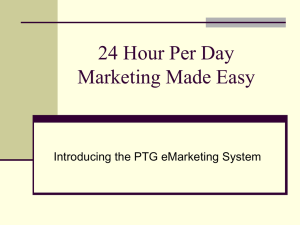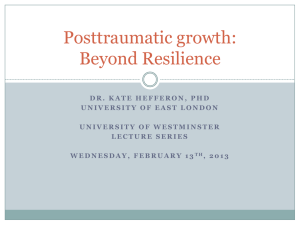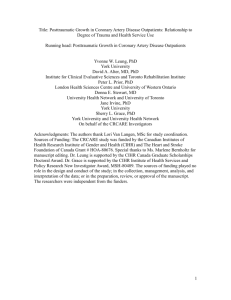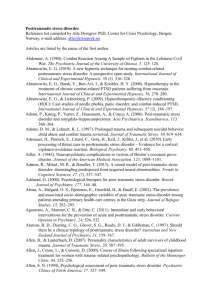Effects of Trauma Intensity on PTG: Depression, Social Support
advertisement
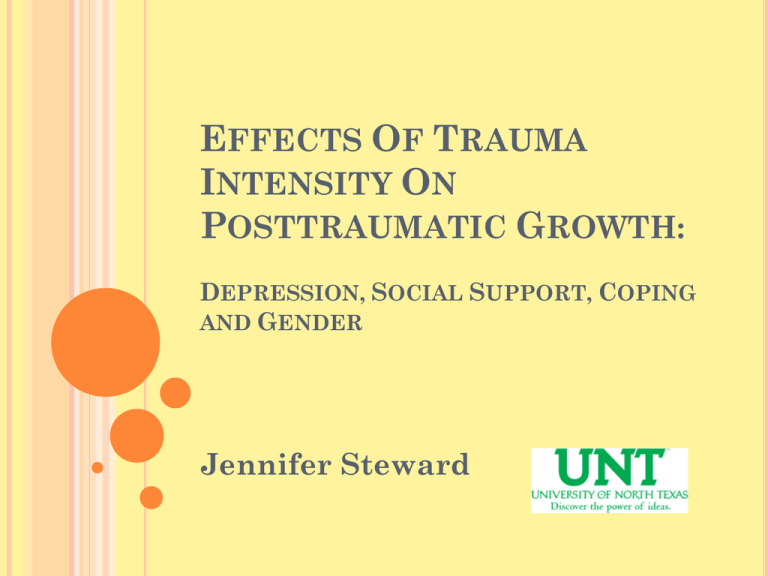
EFFECTS OF TRAUMA INTENSITY ON POSTTRAUMATIC GROWTH: DEPRESSION, SOCIAL SUPPORT, COPING AND GENDER Jennifer Steward TRAUMA Study of how events effect people National Comorbidity Study (Kessler, Chiu, Demler, & Walters, 2005) 60% of Men 51% of Women Aftermath Distress Posttraumatic Stress Disorder (PTSD) PTSD RELATIONSHIPS Common PTSD Correlates: Meta Analysis (Helgeson, Reynolds, & Tomich, 2006) Depression Trauma Severity Female more likely than males Lack of Social Support has also been shown to be related to greater levels of PTSD (Ozer et. al, 2008; Brewin, Andrews & Valentine, 2000). POSTTRAUMATIC GROWTH Positive consequences following trauma The ability to thrive after experiencing a traumatic event, with individuals showing an increase in emotional, cognitive and/or psychological resources. (Wild & Paivio, 2003) Two separate continuums, as opposed to two sides of the same continuum. (Borja, Callahan, & Long, 2006) Variables can be correlates of both PTG and PTSD CURRENT FINDINGS IN PTG Depression Negative relationship, after two years (Helgeson, Reynolds, & Tomich, 2006) Coping Positively related to problem- and emotion-focused coping (Linley & Joseph, 2004) Social Support- Inconsistent results Weiss (2002)- Social support predicts PTG Linley & Joseph (2004)- Does not, but satisfaction with social support does. Gender- Women are shown to experience more growth (Helgeson, Reynolds, & Tomich, 2006) TRAUMA INTENSITY Large amount of variance in the experience of the trauma Literature evaluation of traumatic events Subjective experience of the trauma “There is no single profile of a [trauma victim], as the extent and the nature of the impact varies from person to person” (Futa, Nash, Hansen, and Garbin, 2003) TRAUMA INTENSITY & PTG Studies have shown that events perceived as more severe were related to more PTG. (Helgeson, Reynolds, & Tomich, 2006; Morris et al., 2005) PURPOSE OF THE STUDY Observe the effect trauma severity has on the relationship between PTG and depression, social support, coping strategies, and gender. Clarify the relationships with PTG METHODS USED 598 UNT students were surveyed using an online mass testing experiment through the UNT Psychology Department All students received partial course credit for their participation Questionnaires Used Traumatic Events Questionnaire PTSD Checklist Posttraumatic Growth Inventory Brief Cope Quick Inventory of Depressive Symptomatology Multidimensional Scale of Perceived Social Support ANALYSIS Creating trauma categories Two different splits Median Split- Score of 25 Clinical Value- Score of 44 (Blanchard, Jones-Alexander, Buckley, & Forneris, 1996 ) Gender- Looked at mean PTGI scores for both genders are each split. OUR FINDINGS Median Split Depression- Coping- Social Support- Clinical Split All variables showed even stronger amplification of PTG OUR FINDINGS (CONT.) o Gender Differences Median split- no significant differences Clinical split-Low trauma group = Women had more PTG High trauma group = Men had more PTG 70 60 Male Low Severity PCL Scores 50 40 Male High Severity 30 Female Low Severity 20 10 Female High Severity 0 Median Clinical WHAT IT MEANS/CONCLUSIONS Subjective trauma severity matters Clarification of PTG relationships in the literature Implications towards future research REFERENCES Blanchard, E.B., Jones-Alexander, J., Buckley, & T.C., Forneris, C.A. (1996). Psychometric properties of the ptsd checklist (PCL). Behaviour Research and Therapy, 34(8), 669-673. Borja, S.E., Callahan, J.L., & Long, P.J. (2006). Positive and negative adjustment and social support of sexual assault survivors. Journal of Traumatic Stress, 19(6), 905-914. Brewin, C.R., Andrews, B., & Valentine, J.D. (2000). Meta-analysis of risk factors for posttraumatic stress disorder in trauma-exposed adults. Journal of Consulting and Clinical Psychology, 68(5), 748-766. Futa, K.T., Nash, C.L., Hansen, D.J., & Garbin, C.P. (2003). Adult survivors of childhood abuse: An analysis of coping mechanisms used for stressful childhood memories and current stressors. Journal of Family Violence, 18, 227-239. Helgeson, V.S., Reynolds, K.A., & Tomich, P.L. (2006). A meta-analytic review of benefit finding and growth. Journal of Consulting and Clinical Psychology, 74(5), 797-816. Linley, P.A. & Joseph, S. (2004). Positive change following trauma and adversity: A review. Journal of Traumatic Stress, 17, 11-21. Morris, B.A., Shakespeare-Finch, J., Rieck, M., Newbery, J. (2005). Multidimensional nature of posttraumatic growth in an Australian population. Journal of Traumatic Stress, 18(5), 575-585. Ozer, E.J., Best, S.R., Lipsey, T.L., & Weiss, D.S. (2008). Predictors of posttraumatic stress disorder and symptoms in adults: A meta-analysis. Psychological Trauma: Theory, Research, Practice and Policy, S(1), 3-36. Tedeschi, R. & Calhoun, L. (1996). The posttraumatic growth inventory: Measure the positive legacy of trauma. Journal of Traumatic Stress, 9, 455-471. Weiss, T. (2002). Posttraumatic growth in women with breast cancer and their husbands: An ntersubjective validation study. Journal of Psychosocial Oncology, 20, 65-80. Wild, N.D. & Paivio, S.D. (2003). Psychological adjustment, coping, and emotional regulation as predictors of posttraumatic growth. Journal of Aggression, Maltreatment, & Trauma, 8(4), 97-122.
